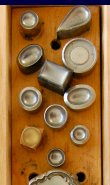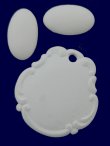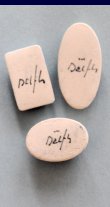
Support VCO and like us on Facebook
Verwoerd Ceramics Online
|
|
|
Manufacturing Delft Medallions How exactly are Delft medallions made? Are they pottery or porcelain? Are they signed, and what does the signature tell us? All you should know about Verwoerd Delft medallions, and more. |
 |
Everything, apart from the silver frame that is, is made in the Verwoerd workshop. Everything from scratch, starting with basic white baking pottery clay. First the clay is de-aired, initially by wedging, and in later years in a machine called a vacuum pug in order to prevent air bubbles and cracks during firing. The clay is then formed into small balls that are placed under a hardened steel die with the exact negative shape of the medallion - not unlike coining - and with a size that takes into account the degree of shrinkage during the drying process. The steel dies are custom-made to the specifications of the Verwoerd Studio, with the help of an oversized plaster of Paris model of the medallion, and a reduction lathe. When a new model or a differently sized medallion was planned, the design and production of a new die could take several weeks. |
| When the newly pressed clay medallions have sufficiently dried, the sharp rims that could easily chip or crumble are removed with a moist sponge. The clay medallions are then fired in a pottery kiln at 1060 degrees centigrade to become bisque or biscuit. After firing and cooling off, the bisque medallions are covered with a white engobe, i.e. a thin, white baking slip layer that is used to mask the inherent touch of yellowness of the pottery clay. The composition of the engobe is a production secret. Sometimes the medallions are referred to as porcelain. However, technically speaking the Verwoerd medallions are pottery, as is virtually all Delft. |  |
| The intended scenery is then painted on top of the engobe, traditionally using cobalt based blue pottery paint, and a variety of tiny brushes. The paint starts out as a dull black or blueish-grey, but during the firing process it turns into a rich blue. The exact composition, and the addition of water and other dilution agents determine the shades of blue. As the competition between Delft factories was quite fierce, and a pleasing, non aggressive shade of blue is considered to be a sign of quality, the composition of the paint too is a well guarded production secret. |
 |
The Verwoerd medallions come in many different sizes and shapes, the largest size being 44mm (1.732 Inch) and the smallest 7mm (0.275 Inch). Common shapes are round and oval cabochons. Painting a windmill scenery on a tiny 7mm dome shaped object is no small fry. One is easily reminded of the famous Japanese ukiyo-e artist Katsushika Hokusai, who is said to have drawn birds in flight on a single grain of rice. The insert shows a 7mm round medallion, and a rare 7x21mm oval shape. The rice has been added for comparison. For an overview of all shapes and sizes produced by the Verwoerd Ceramics Studio see our Windmill Series and Rare Delft Designs galleries. |
| Initially, the reverse of the Verwoerd medallions is rubber stamped “Delfts”, short for “Delfts Blauw” (Blue Delft). The word Delfts is shown in an oval cartouche featuring a fan of three short stripes at the top. From 1950 onwards the Delfts signature is simply painted by hand. Early specimens still show the three stripes symbol. Next the medallions are glazed. The larger models are glazed on both sides, and each such piece is placed on tiny triangular kiln spurs. After firing once more at 1060 degrees - so as to allow bisque firing and glost firing in the same kiln - and grinding off eventual spur marks, the medallions are ready to be shipped. Signing and glazing the reverse of the medallions took precious production time, and could not continue indefinitely. Verwoerd signing stopped entirely during the 1960's. Other producers started using printed marks. There is more about signing in our Compact Guide To Delft Jewelry Signatures. |  |